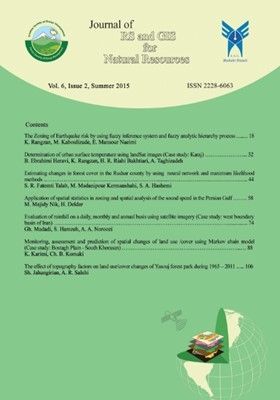Monitoring, assessment and prediction of spatial changes of land use /cover using Markov chain model (Case study: Bostagh Plain - South Khorasan)
Subject Areas : Geospatial systems developmentKamran Karimi 1 , Choughi Bayram Komaki 2
1 - PhD. Student of Desertification, College of Rangeland and Watershed Management, Gorgan University of Agricultural Sciences & Natural Resources
2 - Assis. Prof. College of Rangeland and Watershed Management, Gorgan University of Agricultural Sciences & Natural Resources
Keywords:
Abstract :
Monitoring and optimal management of natural resources is requiring an update and accurate information. In this context, land use/cover maps is considered as a one of the most important sources of information on natural resources management. Optimal management of resources requires assessment and understanding of the changes and degradation of resources in the past. It also needs to have an accurate plan in order to control and inhibition of the happened destruction potential in future. The Markov chain model is one of the most efficient methods for predicting changes in land use and land cover. In this research, land cover changes in previous years and the possibility of predicting in the future are investigated in Bostagh plain using the Markov chain model. Therefore, using MSS (1987), ETM+ (2002) and OLI (2014) images sensors and region ancillary information, land use map is provided and 2024 land use map is predicted too. Land use maps were performed using kappa coefficient after correcting satellite images, determining training samples, and evaluating classification accuracy. According to the results, bare/barren and rangeland classes are the most dynamic existing usage in the region. The area percentage of these lands during 1987 to 2014 was 21.64% subtractive and 31.14% additive respectively. This represents a total degradation and replacement of the weaker use in the region. The results of predicting changes in the time interval 2014-2024, showed that 98% of residential lands, 88% of bare land, 77% of saline land, 45% of rangeland, and 37% of agriculture will remain unchanged. Moreover, the conversion of rangeland to bare land (41.94%) are the highest, and the conversion of bare lands to residential lands (0.02%) and rangeland to residential lands (0.03%) are the lowest possibility of conversion. Predicting maps derived from the Markov chain model are very important to provide an overview for better natural resources management. Landuse changes Satellite images Predict of changes Markov chain model Bostagh plain


